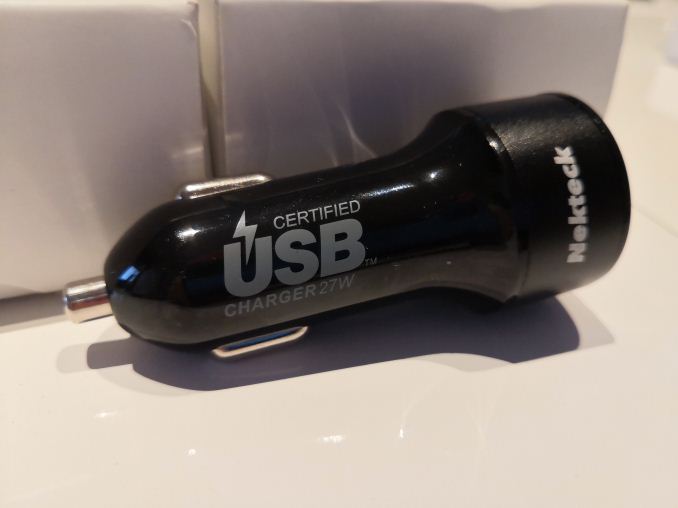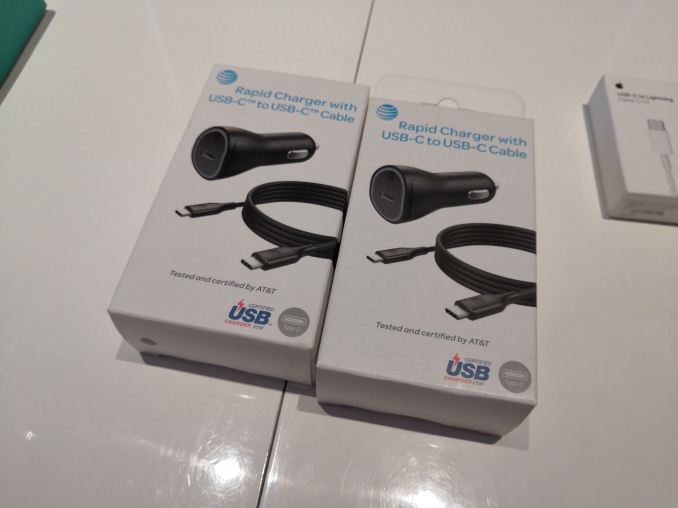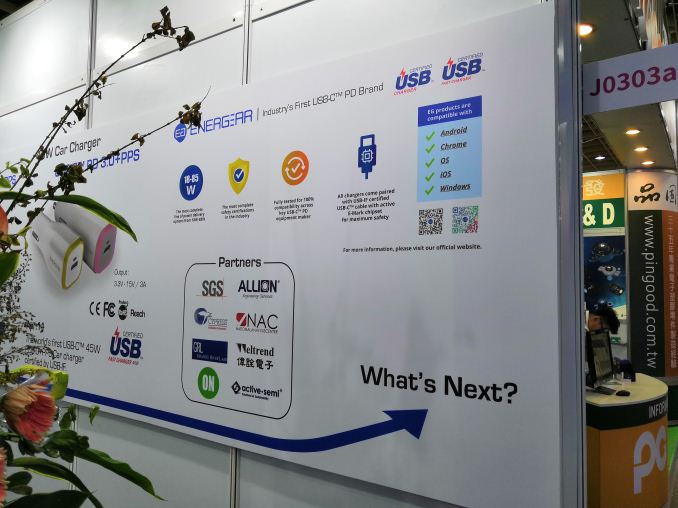USB-IF and Fast Charging: New Standard Logo with Wattage Listed
by Ian Cutress on June 13, 2018 12:00 PM EST- Posted in
- SoCs
- Systems
- charging
- Trade Shows
- USB-IF
- USB
- Computex 2018
- Fast Charging

When discussing industry standards, the sexy ones are involved around performance: if you can breathe PCIe 4.0 or PCIe 5.0 into a sentence, people start listening. One of the standards we actually deal with day in and day out though is around charging and USB charging. Not only do we have a series of standards in play for chargers over USB, but there are also a ton of companies that do their own thing in the mix outside of those standards. It can be, if we’re honest, a bit of a mess.
One of the new ways that the USB-IF is trying to fix this is with certified chargers and fast chargers. The new programs, previously announced in 2016 and back at CES 2018, are finally coming to fruition, and the USB-IF is showing off some of the new products released under the new standards. By using 11 certified test centers worldwide, the newest fast charging standards will enable wall chargers, car chargers, and other dedicated charging devices to carry a logo that states both that the unit adheres to the standards, but also the maximum power.
This listing of power is going to be a good thing. Users can know that if they need a 45W or a 65W charger, that what the logo says on the box is what the unit can handle. At the show we bumped into a company that already has chargers certified to 25W, 27W, 45W, and 65W. It was as clear as day which product was targeted for what sort of application.
Meanwhile the fast charging standard, which implements the USB Power Delivery Programmable Power Supply standard, allows for devices and chargers to do finer-grained voltage negotiation between USB-PD's major power classes (5V, 12V, etc). This allows a device to request the highest voltage it can take, as opposed to having to drop down to a lower power class entirely.
USB-IF also spoke about USB 3.2, with ASMedia at the show having a prototype 2x2 PHY on display. Despite the standard being finalized in September 2017, the first products and controllers are unlikely to be available until 2019 at the earliest.
| Want to keep up to date with all of our Computex 2018 Coverage? | ||||||
 Laptops |
 Hardware |
 Chips |
||||
| Follow AnandTech's breaking news here! | ||||||












28 Comments
View All Comments
peevee - Thursday, June 14, 2018 - link
"Like I alluded to, it's entirely the fault of USB-IF, UL, IEC, and other regulatory and standards bodies for not raking offenders over the firepit until compliance or death."They are not government organizations.
The problem is that certain governments (US and China) do not enforce standard compliance, and the latter even helps with IP theft and counterfeiting.
boozed - Friday, June 15, 2018 - link
Recently I found some ultra cheap USB cables on ebay that use what appears to be _steel_ wires with copper coloured coatings. Heat them sufficiently and they burn just like steel wool! By comparison, aluminium sags and copper merely glows.As if copper coloured aluminium wasn't bad enough...
Needless to say, the performance was terrible.
peevee - Wednesday, June 13, 2018 - link
"Charger rated for 20Vx5A (the absolute max) should be able to do 5Vx3A, 9Vx3A, 15Vx3A and 20x5A.Charger rated for 20Vx1.5A should be able to do 5Vx3A, 9Vx3A, 15Vx2A and 20x1.5A.
The idea is to keep going up a voltage to 3A then moving up to the next voltage upto the max of 20V, at which point you can finally go up to 5A. This applies to both power supplies/chargers and devices, so your hypothetical scenario shouldn't happen."
How it should not? The expected 5V*5A will never get supplied... It is exactly the case discussed, 15W from a "60W" charger.
ZeDestructor - Wednesday, June 13, 2018 - link
The device should never ask for more than 5Vx3A, so the situation should never arise that the tablet will want that particular combo in the first place. If the tablet did want more power, then it should have profiles for 9V and/or 15V and/or 20V.Impulses - Thursday, June 14, 2018 - link
They've got plenty of blame to share, but when manufacturers go out of their way to use the USB-IF certified logo without permission and/or change things up after certification, well... Plenty of blame to toss all around.The_Assimilator - Wednesday, June 13, 2018 - link
Oh good, so they decided to address confusion over USB charging by... introducing more confusion via creating 5 different chargers, when they could have just created ONE 65W model that auto-negotiates down to whatever the device needs.At this point I'm 99% certain that the USB-IF is trying to destroy USB, not promote it. There is only so much incompetence I can assign to one body before assuming malice.
As for "Tested and Certified by AT&T"... I think I'd trust an arbitrary Chinese seller off Ebay more.
A5 - Wednesday, June 13, 2018 - link
That 65W unit is almost certainly a more complex design than a 25W unit. No one is going to pay the extra money for a laptop-rated charger to use with their phone.Death666Angel - Wednesday, June 13, 2018 - link
Most laptops I've dealt with the last years were of the low end variety (Atom or Pentium based) and used even lower 45W bricks. :) 65W is encroaching high end territory.Impulses - Thursday, June 14, 2018 - link
That's still higher than most people need with a phone or that what anyone would bundle with one... IIRC the original Pixel XL only goes up to 18W for a short period when it's really low, my Pixel (5") never even uses more than 15W on Google's PD/certified 18W charger.A 45W charger is gonna be larger and more expensive... A well designed and spec conforming one WILL auto negotiate down to whatever a phone needs tho, you don't need different chargers if you have a high powered one and the need for it...
Not sure if that's the impression Assimilator got...
eBob - Wednesday, June 13, 2018 - link
I suspect that they are from an arbitrary Chinese manufacturer and AT&T just made sure that a sample could handle the load. I would prefer to see either a UL or ETL label.